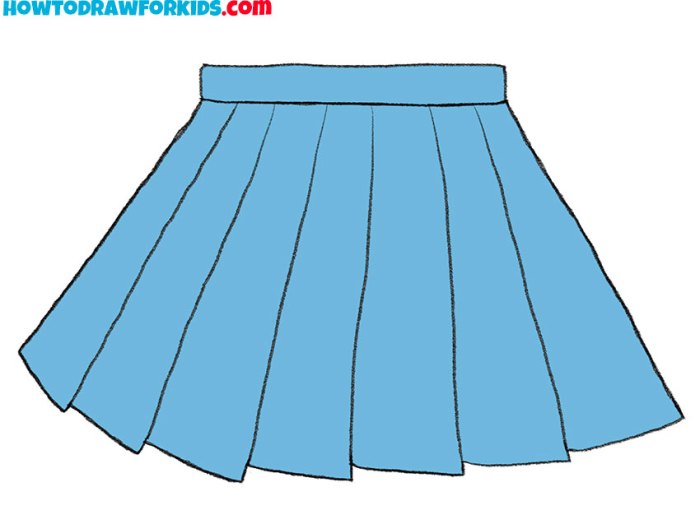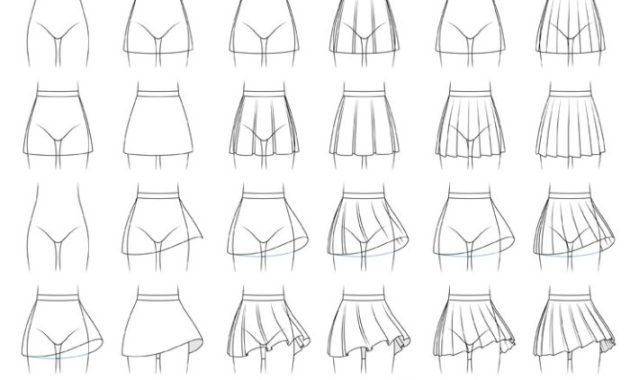Basic Skirt Shapes

How to draw a skirt drawing easy – Let’s dive into the wonderful world of skirt drawing! We’ll cover three fundamental skirt shapes: the A-line, pencil, and circle skirt. Mastering these will give you a strong foundation for creating all sorts of stylish skirt designs. We’ll break down each shape step-by-step, focusing on the key lines and curves that define their unique silhouettes.
A-Line Skirt
The A-line skirt, named for its resemblance to the letter “A,” is characterized by a fitted waist that gradually flares out towards the hem. This creates a flattering and versatile shape suitable for many occasions.To draw an A-line skirt, start by sketching a narrow rectangle for the waist. From the bottom corners of this rectangle, draw two slightly curved lines extending downwards and outwards, meeting at a wider point to form the hemline.
The angle of these lines determines the flare of the skirt; a steeper angle results in a more dramatic A-line, while a gentler angle creates a more subtle flare. Imagine a simple isosceles triangle, with the top representing the waist and the base representing the hem. The sides of the triangle are your gently curving skirt lines. The longer the base of your triangle (relative to the height), the wider the skirt will be.
Pencil Skirt
The pencil skirt is known for its sleek, form-fitting silhouette, typically falling to the knee or slightly below. Its simple, streamlined design makes it a classic choice for professional and elegant looks.Begin by drawing a long, narrow rectangle to represent the skirt’s front. The width of this rectangle determines the overall slimness of the skirt. From the top corners of this rectangle, draw two slightly curved lines that taper inward towards the bottom, meeting to form a slightly pointed hemline.
These curves should be subtle; the pencil skirt is all about clean lines and a fitted shape. Unlike the A-line, there’s minimal flare; the sides are nearly straight and parallel, creating a column-like effect. Consider adding a slight inward curve at the bottom to suggest a more natural drape.
So, drawing a skirt? Super chill, right? Just think simple shapes – maybe a trapezoid or a circle for the base, then add some folds. Want a little something different? Check out this easy drawing of a hog for some inspiration on how to handle curves and volume – those piggies have some seriously cute folds! Then, apply that same approach to your skirt, adding some fun details like pleats or a little ruffle at the bottom.
Easy peasy, lemon squeezy!
Circle Skirt, How to draw a skirt drawing easy
The circle skirt is a full, circular skirt that creates a dramatic and feminine look. Its design is based on a full circle of fabric, gathered at the waist.Start by drawing a circle. This circle represents the hemline of the skirt. Then, draw a smaller circle inside the first, representing the waistline. The distance between the two circles determines the length of the skirt.
Connect the two circles with many evenly spaced lines, creating the gathered effect. The more lines you draw, the more defined the gathers will be. Consider that the fabric at the waist will naturally bunch or gather to form the circular shape, so don’t worry about making the lines perfectly straight. The overall effect should be a smooth, full circle from the waist to the hem.
Skirt Shape Comparison
| Skirt Type | Characteristics | Proportions/Angles | Suitable Occasions |
|---|---|---|---|
| A-Line | Fitted waist, gradually flares out | Varying angles from waist to hem, creating a triangular shape | Casual outings, semi-formal events, everyday wear |
| Pencil | Form-fitting, usually knee-length or below | Nearly straight, parallel lines from waist to hem, minimal flare | Professional settings, formal events, elegant occasions |
| Circle | Full, circular shape, gathered at the waist | Full circle hemline, distance between waist and hem determines length | Parties, special occasions, festive events |
Illustrating the Movement of a Skirt

Capturing the movement of a skirt in a drawing adds dynamism and life to your artwork. Whether it’s a gentle sway in the breeze or a dramatic swirl during a dance, understanding how to depict motion is key to creating believable and engaging figures. This section will explore techniques for illustrating this movement, focusing on line variations and implied motion through different poses and styles.
The key to drawing a moving skirt lies in understanding how fabric drapes and flows. Unlike rigid forms, fabric reacts to gravity and air currents, creating soft curves and folds. By using varied line weights and suggesting underlying forms, you can effectively convey the illusion of movement.
Depicting Movement Through Line Variation
The weight and direction of your lines are crucial in suggesting movement. For a skirt billowing in the wind, use lighter, more flowing lines to depict the fabric’s lightness and airiness. Conversely, heavier, more defined lines can illustrate a heavier fabric or a tighter, more controlled movement. Experiment with curving lines to show the graceful sweep of a skirt, and use short, broken lines to suggest texture and the subtle shifts in the fabric.
Consider using hatching or cross-hatching to add depth and shadow, further emphasizing the folds and creases created by the movement. For example, imagine a long, flowing A-line skirt. The lines at the waist would be relatively straight and close together, while the lines at the hem would be much longer, more curved, and spaced further apart to suggest the skirt’s expansion as it moves.
Illustrative Poses Showcasing Skirt Movement
Different skirt styles move in unique ways. A tight pencil skirt will move much differently than a full, flowing ballgown. Let’s consider a few examples:
A simple A-line skirt on a figure walking briskly will have a subtle ripple at the hem, with slightly more pronounced movement at the sides. The lines should suggest a slight upward curve at the back, indicating the fabric being lifted by the movement of the legs. In contrast, a full circle skirt on a twirling figure will create a dramatic, almost circular shape.
The lines should radiate outwards from the waist, with the longest and most curved lines at the bottom, suggesting the fabric’s full expansion. Finally, a pleated skirt, when in motion, will show the pleats expanding and contracting rhythmically. The lines will be more structured, with distinct folds visible, emphasizing the pleats’ movement.
Step-by-Step Guide to Drawing a Skirt in Motion
Let’s draw a figure in a flowing maxi skirt caught in a gentle breeze.
- Start with a basic figure sketch. Focus on the pose, ensuring it suggests movement. Perhaps the figure is walking or slightly leaning into the wind.
- Lightly sketch the basic shape of the skirt around the figure. Keep it loose and flowing, avoiding rigid lines.
- Begin adding details to the skirt, focusing on the folds and curves created by the wind. Use lighter lines for areas where the fabric is most lifted and heavier lines where it’s closer to the body.
- Refine the lines, adding subtle details like ripples and creases. Vary the line weight to emphasize the movement and texture of the fabric.
- Add shading and highlights to give the skirt dimension and depth. Consider using hatching or cross-hatching to indicate shadow in the folds.
- Erase unnecessary lines and finalize the drawing. Add details like shoes or accessories to complete the scene.
Adding Characters and Accessories: How To Draw A Skirt Drawing Easy

Now that we’ve mastered the basics of skirt drawing, let’s add some personality! Adding characters and accessories breathes life into your sketches, transforming simple shapes into dynamic and expressive illustrations. We’ll explore how to effortlessly incorporate characters and stylish additions to enhance your skirt drawings.Let’s start by designing simple characters to showcase the versatility of different skirt styles.
Pencil Skirt Character Design
Imagine a confident businesswoman. Her pencil skirt is a classic navy blue, crisp and tailored, hinting at a structured wool fabric. The skirt falls straight to her knees, accentuating her figure. She’s paired it with a simple white blouse, the collar neatly buttoned. Her hair is pulled back in a sleek ponytail, showcasing sharp, defined cheekbones.
She wears classic black pumps with a small, sensible heel, completing the polished professional look. The slight sheen of the skirt suggests a subtle texture, perhaps a hint of silk woven into the wool. The overall impression is one of sophistication and understated elegance.
Flared Skirt Character Design
In contrast, picture a playful young artist. Her flared skirt is a vibrant, swirling print of bright colors and abstract shapes, suggesting a lightweight cotton or linen. The skirt’s full shape flows around her ankles, creating a sense of movement and freedom. She wears a simple, loose-fitting graphic tee, the colors echoing the vibrant tones of her skirt.
Her hair is loose and wavy, cascading down her shoulders. She’s sporting comfortable canvas sneakers, adding to her casual and carefree vibe. The fabric of the skirt appears soft and flowing, almost dancing with her every move. This look exudes creativity and youthful energy.
Complementing Skirt Styles with Shoes and Accessories
The right shoes and accessories can significantly impact the overall aesthetic of your skirt drawing. For instance, a pencil skirt, known for its structured silhouette, pairs well with elegant heels, pointed-toe flats, or even sleek ankle boots. These choices maintain the refined and polished feel. A simple belt can further enhance the waistline definition. In contrast, a flared skirt, characterized by its volume and movement, complements casual footwear like sneakers, sandals, or even ballet flats.
Accessories like a wide-brimmed hat or a statement necklace can add a touch of whimsy or sophistication, depending on the overall style.
Detailed Character Description: A Summer Day Look
Let’s craft a complete character description. Our character is wearing a flowing midi-length skirt in a light, floral-printed cotton. The fabric is soft and drapes beautifully, gently swaying with each movement. The skirt’s hemline is slightly uneven, adding a touch of bohemian charm. She’s paired it with a simple off-white linen tank top.
Her hair, a warm chestnut brown, is styled in loose, beachy waves. She’s wearing comfortable leather sandals, adorned with delicate, braided straps. A straw tote bag hangs casually from her shoulder, adding to the relaxed summer vibe. A delicate silver necklace with a small pendant completes the ensemble. The overall impression is one of carefree summer elegance, highlighting the fluidity and grace of the skirt’s fabric.
Common Queries
What kind of pencils are best for drawing skirts?
HB, 2B, and 4B pencils are great for sketching and shading skirts. Experiment to find your preference.
How do I draw realistic wrinkles in a skirt?
Observe how fabric drapes in real life. Use short, curved lines to suggest wrinkles and folds, paying attention to the direction of the fabric.
Can I use digital tools to draw skirts?
Absolutely! Programs like Procreate and Photoshop offer excellent tools for digital fashion illustration.
What’s the best way to practice?
Start with simple shapes, then gradually add details. Practice drawing different fabrics and poses to build your skills.

